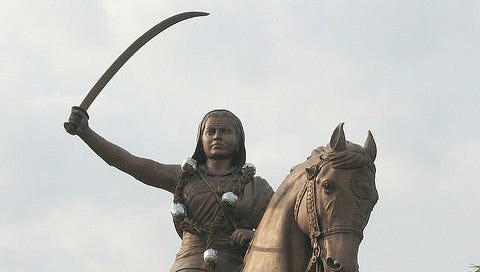In the history of Karnataka, there have been many brave women warriors, who took on the invaders single handedly. Rani Abbaka Chowta of Ullal, who made the Portuguese navy retreat from Mangalore, Keladi Chennamma who beat back Aurangzeb and his Mughal army, Onake Obavva who defended the fort of Chitradurga with just a pestle from the forces of Hyder Ali. And to such an illustrious pantheon, belonged Rani Chennamma of Kittur. While we know of the Rani of Jhansi’s fight against British, Kittur Rani’s preceded hers much earlier. The backdrop to this was the Doctrine of Lapse, one of the most controversial policies introduced by the British around 1847.
As per the doctrine, if the ruler of any princely state, under the suzerainty of the East India Company died without producing a heir, it would have it’s princely status abolished, and be annexed by the British. The Doctrine actually rode over the right of an Indian ruler to choose his succesor, in the event of not having a heir. On top of it the British, decided whether the succesor choosen was competent or not. To put it very simply, the princely states were essentially slave states to the British, with no rights of their own. The Doctrine began to be implented vigorously by Lord Dalhouise, then Governor General, from 1848 to 1856. Satara was the first such state to be annexed by Dalhousie, in 1848, using this doctrine, though some other princely states too were annexed earlier.
Chenamma was born on October 23, 1778 in a small village called Kakati, around 6 km to the north of Belagavi, to Dulappa , the head of that village. At a very young age itself she learnt horse riding and archery, and at 15 she was married to Raja Mallasarja, the ruler of Kittur a princely state now in Belgavi district. Her husband was a great warrior himself, who had fought against Tipu Sultan, and was captured by him. There was a story of how he broke out from the prison, and escaped from Srirangapatna disguised as a sadhu. Mallasaraja however passed away in 1824, followed by her son Shivalinga Rudra soon after, leaving her distraught.
A grief stricken Chenamma, throw herself into the administration and affairs of the kingdom, aided by wise people like Guru Sidappa, Sangoli Rayanna around her. She proved to be an able and competent ruler, winning the respect of her subjects. She adopted Shivalingappa and made him the heir to the throne, which predictably irked the British who demanded that she expel him, and refused to accept him as the succesor. The then district collector of Dharwad, St John Thackeray, appointed Mallappa Setti and Haveri Venkata Rao, to look after the affairs of Kittur, and also ordered to lock the Treasury till further orders from the Company.
Chenamma sent letters to Thackeray, the commisioner Chaplin and Mountstuart Elphinstone pleading her cause, at the same time allying with neighbouring princely states like Kolhapur. It was in vain as the British attacked Kittur on October 23,1824 with a force of 20,797 men and 437 artillery mainly from the Madras Native Horse Artillery. However the brave warriors of Kittur, led by the Rani put up a valiant fight, forcing the British to retreat. Thackeray was shot dead by Amatur Balappa, the Rani’s personal bodyguard,while two British officers Stevenson and William Elliot were captured as hostages. The traitors Kannuru Verappa and Saradara Mallappa, who had betrayed the Rani were also killed in the assault.
The Rani released both the hostages, hoping this would stop the war with the British,who however attacked Kittur again on December 3, 1824 with a much larger army. It was another fierce battle in which the sub collector of Solapur, Munro was killed. Though Chennamma led a fierce assasult on the British aided by her valiant army chief Sangoli Rayanna, she was ultimately defeated. Her faithful lieutnant Gurusidappa, was captured while Rani Chennamma along with her nieces Janaki Bai, Veeramma, was placed in captivity at Bailhongal Fort, where she ultimately passed away on February 21, 1829 at the age of 50.
However Rayanna decided to continue the struggle against the British, he escaped along with the Rani’s adopted son Shivalingappa,whom he sought to make the next ruler of Kittur. proved to be a thorn in the flesh for British, harassing them with constant raids and attacks in and around Kittur. The British retaliated by imposing heavy taxes on the areas that Rayanna controlled.
He mobilized the local residents against the British and waged a guerilla war. With a well trained army under his command, he attacked the British, as well as the corrupt Zamindars most of whom were collaborating with them. Along with his close aide Gajaveera, began to organize constant raids on British officials in the region. He was also one of the early revolutionaries who made use of guerilla tactics, much like Kerala Varma Pazhassi Raja and later Vasudev Balwant Phadke. He not just built up an army, but also began to recruit the local peasants in his army, and made good use of their knowledge of the area. He would often vandalize British offices, and loot the money, and soon he became a constant terror to them.
Unable to capture him directly, the British used treachery, this time through Rayanna’s uncle Lakshmanraya. The man who harassed the British for a long time, was finally caught by betrayal and treachery of his own. Imprisoned along with Shivalingappa, Sangoli Rayanna, was hanged on January 26th, 1831 at Nandagad. Kittur came under British rule, however the legacy of Rani Chennamma and Sangoli Rayanna, is still celebrated there.
My article on Kittur Rani Chenamma here




